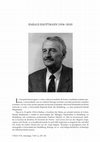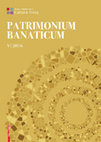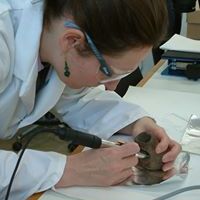Papers by Florin Drasovean
Ephemeris Napocensis, 2023
The article is a variant in Romanian of chapter 4.8 of the monograph of the Foeni-Cimitirul ortod... more The article is a variant in Romanian of chapter 4.8 of the monograph of the Foeni-Cimitirul ortodox site, which was published in 2021. Starting from the Eneolithic discoveries from this site, the characteristics of the ceramics from the Banat area are analyzed, as well as their analogies in Transylvania. These were analyzed in correlation with the 14C data and it is concluded that the Foeni Cultural Group is the one that has a contribution to the genesis of the Petreşti Culture.
Wissensschichten. FESTSCHRIFT FÜR WOLFRAM SCHIER ZU SEINEM 65. GEBURTSTAG, 2022
Cercetari Arheologice, 2020
Abstract: On the evolution of the Precucuteni and Cucuteni cultures. Bayesian analysis of 14 C da... more Abstract: On the evolution of the Precucuteni and Cucuteni cultures. Bayesian analysis of 14 C data vs. chrono-typology The study analyses the absolute chronology of the Precucuteni and Cucuteni cultures through the Bayesian modelling of 14 C data. The available data was ordered in cultural models and, where possible, in stratigraphic models. The temporal limits were extracted within these models for each of the stratigraphic units from which the analysed samples were collected. The limits established by this method allowed for a more accurate chronology of the different layers of the Precucuteni and Cucuteni sites in Romania and have created a solid starting point for the correspondence analysis of the ceramic belonging to these cultures.
PATRIMONIUM BANATICUM VIII/2018, 2018
PATRIMONIUM BANATICUM VIII/2018, 2018
Studii de Preistorie, 2018
In the researches undertaken in 2012 on the site of Sânandrei, level 5d was discovered a pendant ... more In the researches undertaken in 2012 on the site of Sânandrei, level 5d was discovered a pendant made from a valve of a seashell of Spondylus gaederopus Linnaeus, 1758. The level 5d have been dated between 5483-4857 calBC and belongs to the Banat Culture , phase IIB-IIC. Unlike the other pendants in Western and Central Europe, the edge of the Sanandrei seashell valve was painted with a black color, and in a hole that was made later hosted a bead made from the same material. Perhaps these details were of particular importance and precise significance for the bearer / wearer of the pendant, going as far as the possibility of changing its original purpose/use.

Tibiscum, 2017
L a începutul lunii august s-a stins o altă personalitate de frunte a mediului academic ger-man, ... more L a începutul lunii august s-a stins o altă personalitate de frunte a mediului academic ger-man, o personalitate care şi-a dedicat întreaga activitate cercetării preistoriei europene şi asiatice, cel care a fost, pentru aproape un deceniu şi jumătate, directorul Institutului de Istorie străveche şi veche a Universității Ruprecht-Karls din Heidelberg, s-a stins profesorul Harald Hauptmann. Născut la 19 aprilie 1936 la Ratkau, o localitate din Silezia, pe actualul teritoriu al Cehiei, Harald Hauptmann a studiat la universitățile din Tűbingen, Saarbrűchen şi Heidelberg. La Heidelberg, sub coordonarea profesorului Vladimir Milojčić, în 1964 îşi încununează studi-ile cu lucrarea de absolvire Die Keramik der Dimini-und Larissa Zeit aus den Magulen Arapi, Argissa und Otzaki, ce va fi publicată parțial, în anul 1969, împreună cu magistrul său, sub titlul Die Funde der frühen Dimini-Zeit aus der Arapi-Magula, Thessalien, în prestigioasa serie de monografii a Universității din Heidelberg, Beiträge zur ur-und frűhgeschichtlichen Archäologie des Mittelmeerkulturraumes.

Florin Drașovean, Wolfram Schier, Alex Bayliss, Bisserka Gaydarska, Alasdair Whittle, The Lives of Houses: Duration, Context, and History at Neolithic Uivar, Romania, in: European Journal of Archaeology 20 (4), 2017 There is a considerable mix of models for house durations in the literature on Neolithic Europe. ... more There is a considerable mix of models for house durations in the literature on Neolithic Europe. This article presents a summary of a formal chronological model for the Neolithic tell of Uivar in western Romania. We provide estimates of house duration and relate houses to other features of the development of this tell, from the later sixth to the mid-fifth millennium cal BC. Three wider implications are discussed: that the house must be contextualized case by case; that house duration gives powerful insights into the sociality of community; and that houses, surprisingly often taken rather for granted in Neolithic archaeology, should be fully integrated into the interpretation of Neolithic histories. From what perspective , anthropocentric or relational, that may best be done, is open to question; while it may be helpful to think in this case in terms of the lives and vitality of houses, the ability of people to create and vary history should not be set aside lightly.
24 de specialiști și aproape 20 de articole grupate în aproximativ 350 de pagini. Direcția Județe... more 24 de specialiști și aproape 20 de articole grupate în aproximativ 350 de pagini. Direcția Județeană pentru Cultură Timiș propune cititorilor interesați de soarta patrimoniului cultural al județului Timiș, un nou număr al revistei Patrimonium Banaticum: al VI-lea. Volumul este structurat pe șase secțiuni: Patrimoniu arheologic, Patrimoniu arhitectural, Patrimoniu mobil, Conservare-restaurare patrimoniu, Legislație patrimoniu, management cultural, educație culturală și Istorie.

Aşezarea din epoca târzie a bronzului de la Călineşti Oaş. Contribuţii la cercetarea sistemelor d... more Aşezarea din epoca târzie a bronzului de la Călineşti Oaş. Contribuţii la cercetarea sistemelor de fortificaţii din spaţiul carpatic / The Călinești Oaș Late Bronze Age settlement. Contributions towards the systematic research of fortification systems in the Carpathian Basin 33 Doina Benea Observaţii privind producţia opaiţelor romane lucrate la roată din provincia Dacia / Bemerkungen über die Produktion der römischen Lampen bei Drehscheibe geformt aus der Provinz Dacia 51 Ana Cristina Hamat O camee de epocă romană descoperită în cadrul cercetării de la mănăstirea franciscană din Caransebeș / A roman cameo discovered during the study of the Caransebeș Franciscan monastery 69 Bogdan Muscalu Noi puncte arheologice identificate pe raza localităţii Hodoni (com. Satchinez, jud. Timiş) / New archaeological sites discovered near Hodoni village (Satchinez, Timiș) 77 Alexandru Ionescu, Claudiu Toma, Călin Timoc Un nou sit arheologic de secolele II-IV, la sud de localitatea Igriș (jud. Timiș). Date privind arheologia peisajului / A new 2 nd -4 th centuries archaeological site south of Igriș village (Timiș county). Data regarding landscape archaeology 91 Bogdan-Alin Craiovan, Octavian-Cristian Rogozea Contribuții la repertoriul așezărilor atribuite Evului Mediu din vestul României / Contributions towards the medieval settlements repertoire of western Romania 101 Florin Draşovean, Cosmin Ioan Suciu, Dragoş Diaconescu Cercetările arheologice preventive din anul 2015 în Piaţa Sfântul Gheorghe a Timişoarei / The 2015 rescue excavation in Timișoara's Sfântul Gheorghe Square 139 Raoul M. Șeptilici Observații pe marginea unui fals monetar descoperit în Piața Sfântul Gheorghe din Timișoara / Observations regarding a counterfeit coin discovered in Timișoara's Sfântul Gheorghe Square 161 Dragoş Diaconescu Observaţii arheologice privind linia exterioară de fortificaţie a cetăţii turceşti a Timişoarei / Archaeological remarks regarding the outer fortifications of Ottoman Timișoara 165 PATRIMONIU ARHITECTURAL Mihai-Corneliu Popovici-Donici Reconstituiri arhitecturale pentru trei locuințe neolitice din situl Parța pe baza unei metode noi. Concluzii tipologice locale / The architectural reenactment of three Neolithic housing units situated at Parța, as per a New Method. Local typological conclusions 195 Maja Bâldea Studiu de caz. Bisericile de lemn din Coșevița și Pietroasa, județul Timiș / Case study. The wooden curches of Coșevița and Pietroasa, Timiș county 213 Gabriel Szekely Arhitecţi creatori ai Stilului Neoromânesc în zona Banatului / Neo-Romanian style architects in the Banat 235 PATRIMONIU MOBIL Andreea Foanene Icoane bănățene pe sticlă / Banat icons on glass 249
The first part of this article focuses on a discovery that, at least at first sight, could be con... more The first part of this article focuses on a discovery that, at least at first sight, could be considered homogeneous
regarding the context and the place of discovery. In the inventory of the British Museum this appears under the
label „Copper alloy horse trappings (Bronze Age)”, having as place of provenance „Grosswardein (Oradea county)”.








Uploads
Papers by Florin Drasovean
regarding the context and the place of discovery. In the inventory of the British Museum this appears under the
label „Copper alloy horse trappings (Bronze Age)”, having as place of provenance „Grosswardein (Oradea county)”.
regarding the context and the place of discovery. In the inventory of the British Museum this appears under the
label „Copper alloy horse trappings (Bronze Age)”, having as place of provenance „Grosswardein (Oradea county)”.
Le matériel faunique provient de plusieurs niveaux stratigraphiques (culturels) notés du plus ancien au plus récent avec les dénominations Médiéval III (M III), Médiéval II (M II) et Médiéval I (M I) pour la période pré-ottomane (XVe et XVIe siècles mais en avant de 1552) et Olane II (O II), Olane I (O I) pour la période ottomane (1552 - première moitié du XVIIIe siècle) et d’une série de structures archéologiques (complexes - C et fosses - G) qui sont décrites dans les rapport réalisés par le collectif de chercheurs qui ont effectué ces fouilles.
La faune analysée est très variée. Le spectre de faune est en effet composé de poissons, reptiles, oiseaux et mammifères domestiques et sauvages. Ces résultats montrent l’intérêt des habitants de la cité tant pour l’exploitation des animaux domestiques que pour la chasse sporadique dans la région avoisinante ou pour les échanges commerciaux avec d’autres communautés. Ceci démontre la connexion de la cité avec la vie économique régionale et européenne au cours de la période pré-ottomane .
Notre démarche scientifique archéozoologique nous permet d’affirmer que l’exploitation des bovins et des caprinés était très importante pour les communautés humaines de la cité de Timișoara. La conquête ottomane a conduit à des modifications dans la diète des habitants, qui se traduisent par une diminution de l’importance du cochon et une augmentation du poids des caprinés au détriment des bovins. Nous avons également mis en évidence la présence du chameau (niveaux médiévales I et II) et du bison d’Europe (en O II) pour la première fois dans le Banat médiéval.
Une autre découverte importante est l’identification de restes de dinde dans les niveaux médiévales I et II, un oiseau introduit en Europe après la conquête espagnole de l’Amérique à la fin du XVe siècle et considéré en Roumanie comme exotique avant la période ottomane. La dinde sera élevée dans des fermes à partir du début du XVIIe siècle et ne deviendra une espèce domestique commune, au même titre que la poule, le canard ou l’oie, qu’au XVIIIe siècle .
L’identification de restes de la morue de l'Atlantique dans les niveaux médiévaux (M I), alors que cette espèce est également exotique dans cette région du sud-ouest de la Roumanie, montre enfin l’existence de relations commerciales actives et rapides avec le nord de l’Europe à cette période. Le XVIe siècle est marqué par le début de la consommation industrielle de cette espèce de poisson très appréciée dans l’ouest et le nord de l’Europe.